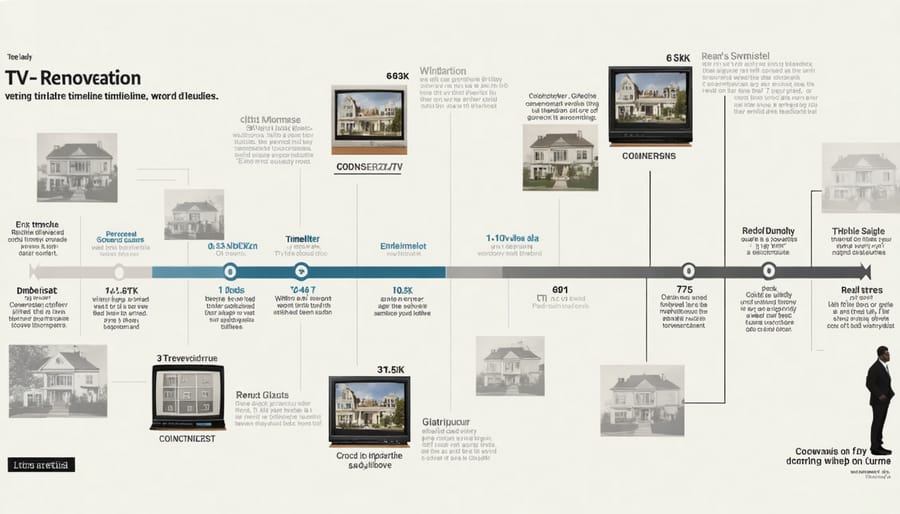Home improvement DIY shows have revolutionized how millions of Americans approach home renovation, transforming weekend warriors into confident DIYers with seemingly unlimited potential. Behind the glossy 30-minute transformations and perfectly staged reveals lies a complex reality that both inspires and occasionally misleads homeowners about the true nature of renovation work.
These shows masterfully blend entertainment with education, offering valuable insights into design principles, project planning, and creative problem-solving. Yet they also compress weeks of intensive labor into neat television segments, often skipping over crucial details that matter most to real-world renovators. From “Property Brothers” to “Fixer Upper,” each program brings its unique perspective on transformation while following a carefully crafted formula that keeps viewers coming back for more.
Understanding the reality behind these shows – including their compressed timelines, hidden professional crews, and strategic editing – helps homeowners set realistic expectations for their own projects while still benefiting from the wealth of design inspiration and practical tips these programs provide. Whether you’re a dedicated DIY enthusiast or simply dreaming of your next home improvement project, recognizing both the value and limitations of renovation television creates a stronger foundation for successful real-world transformations.
The Reality Behind Quick Renovations
Time Compression Tactics
One of the most deceptive aspects of home improvement shows is their masterful time compression. What appears as a seamless three-day renovation on screen actually spans several weeks or even months in reality. Production teams employ sophisticated editing techniques to condense lengthy construction processes into digestible segments.
A typical kitchen renovation that might take 6-8 weeks is often portrayed as a quick turnaround in just 30 minutes of screen time. Crews work around the clock, with multiple teams tackling different aspects simultaneously – something most homeowners can’t replicate. The shows deliberately skip over time-consuming but crucial steps like permit applications, material delivery delays, and unexpected complications.
Behind these quick-cut transformations, production teams typically film hundreds of hours of footage. Editors then carefully select the most dramatic and visually appealing moments, creating a highlight reel that emphasizes the before-and-after impact. While this makes for entertaining television, it can create unrealistic expectations for homeowners planning their own renovations.
Understanding this time compression is essential for viewers planning their own projects. What appears as a weekend warrior project on TV likely requires significantly more time, planning, and patience in real life. Contractors often report clients referencing TV show timelines, highlighting the need to manage expectations about realistic project durations.

Hidden Professional Support
While DIY shows often portray homeowners tackling projects single-handedly, the reality involves extensive professional support working diligently behind the scenes. These productions typically employ teams of 20-40 skilled contractors, electricians, plumbers, and other specialists who work off-camera to ensure projects meet safety codes and quality standards.
The “reveal” moments viewers see actually represent countless hours of professional craftsmanship. Licensed contractors often pre-plan and execute complex structural work, while master electricians and certified plumbers handle critical systems that require permits and inspections. These experts work in shifts, sometimes around the clock, to meet the show’s demanding timelines.
Production companies maintain relationships with local contractor networks in each filming location, carefully vetting professionals who can work efficiently under pressure while maintaining high standards. These teams often include specialty craftsmen for custom cabinetry, tile work, and finish carpentry who complete precise installations that would typically take weeks in just a few days.
While shows emphasize the homeowner’s involvement in design decisions and simple tasks, the heavy lifting happens through this hidden workforce. Understanding this reality helps viewers set realistic expectations for their own renovation projects and appreciate the importance of professional expertise in complex home improvements.
Budget Myths vs. Real Costs
Sponsored Materials and Labor
Home improvement shows often benefit significantly from strategic partnerships with manufacturers, suppliers, and contractors who provide materials and labor at reduced costs or even free of charge in exchange for product placement and exposure. These sponsorship arrangements help productions maintain their tight budgets while showcasing the latest products and design trends.
Major home improvement retailers frequently partner with shows, supplying everything from lumber and tiles to appliances and fixtures. This mutually beneficial relationship allows brands to demonstrate their products in real-world applications while helping shows keep their renovation costs manageable. Manufacturers of specialty items like custom cabinetry, countertops, and high-end appliances also regularly contribute materials to gain visibility among the shows’ targeted audience.
Labor costs are similarly offset through partnerships with local contractors, specialists, and trade professionals. These experts often work at reduced rates or provide their services complimentarily, understanding the valuable exposure and credibility that comes from being featured on popular renovation shows. Many contractors report significant increases in business inquiries following their television appearances.
While these sponsorships help make ambitious renovation projects possible within show budgets, it’s important for viewers to understand that similar projects in the real world would typically cost significantly more. The discounted or donated materials and labor that benefit television productions aren’t available to average homeowners, making it crucial to develop realistic budgets when planning personal renovation projects.

Real-World Cost Breakdowns
While DIY shows often present dramatic transformations with seemingly modest budgets, real renovation costs typically exceed what’s portrayed on television. A complete kitchen remodel, frequently shown as a $15,000-$20,000 project, actually averages $35,000-$65,000 when accounting for all materials, labor, and unexpected issues. These kitchen renovation expenses can climb even higher in urban areas or when selecting premium materials.
Bathroom renovations, often depicted as weekend projects costing under $5,000, typically range from $12,000-$25,000 for a full remodel. Even seemingly simple updates like replacing flooring can be substantially more expensive than shown. While TV hosts might quote $3 per square foot for hardwood installation, real-world costs often reach $12-$15 per square foot, including materials and professional installation.
Other common project costs that exceed TV estimates include:
– Painting interior rooms: $500-$1,000 per room (vs. $200 shown)
– Window replacement: $600-$1,500 per window (vs. $300-400 shown)
– Basic deck construction: $30-$60 per square foot (vs. $15-20 shown)
– Custom cabinetry: $500-$1,200 per linear foot (vs. $200-300 shown)
These figures reflect current market rates, including material costs, proper permits, and professional labor when required. While DIY can reduce expenses, it’s essential to budget realistically rather than relying on television estimates.

Safety and Permits: The Missing Episodes
Required Permits and Inspections
While home improvement shows make renovations look straightforward, they often gloss over crucial legal requirements. Most renovation projects require specific permits from local authorities, and this is something rarely highlighted in these programs. Common permits include those for structural changes, electrical work, plumbing modifications, and additions to your home’s footprint.
Before starting any significant renovation, homeowners must check with their local building department to determine necessary permits. Failing to obtain proper permits can result in fines, forced removal of completed work, or complications when selling your property. Additionally, many municipalities require regular inspections throughout the renovation process to ensure work meets local building codes.
DIY shows typically compress weeks or months of work into 30-minute episodes, often skipping over the permit application process and mandatory inspections. In reality, obtaining permits can take anywhere from a few days to several weeks, and scheduling inspections may require advance notice and cause temporary work stoppages.
Professional contractors featured on these shows handle permit requirements behind the scenes. For DIY homeowners, it’s essential to understand that certain types of work, particularly electrical and plumbing modifications, may legally require licensed professionals regardless of your skill level. Always verify local requirements before beginning any renovation project to ensure compliance with building codes and regulations.
Essential Safety Protocols
While home improvement DIY shows make projects look effortless, safety should always be your top priority. Before attempting any DIY project showcased on television, ensure you have proper personal protective equipment (PPE), including safety glasses, work gloves, ear protection, and dust masks when necessary.
Always read tool manuals thoroughly and familiarize yourself with equipment before use. Unlike TV shows that edit out safety preparations, take time to secure your workspace, removing trip hazards and ensuring proper ventilation. When working with electricity, always turn off power at the circuit breaker and verify with a voltage tester.
Structural modifications require special attention. TV shows often skip permit requirements and professional consultations, but these are crucial steps for safety and legal compliance. Never remove walls without confirming they aren’t load-bearing, and always check for plumbing and electrical lines before cutting into surfaces.
Keep a well-stocked first aid kit readily available and program emergency numbers into your phone. Work with a partner whenever possible, especially for tasks involving ladders or heavy lifting. Remember that TV shows have safety professionals on set and emergency personnel standing by – you’ll need to create your own safety net.
Most importantly, know your limits. If a project feels beyond your skill level, there’s no shame in calling a professional. Safety should never be sacrificed for the sake of DIY ambition.
Making DIY Shows Work for You
While home improvement shows can be incredibly inspiring, it’s essential to approach them with a balanced perspective to make them work for your renovation journey. Start by using these programs as idea generators rather than exact blueprints. Take notes on design elements, color schemes, and layout solutions that resonate with your style and home’s architecture.
Create a realistic framework by focusing on home improvement projects that add value to your property while staying within your capabilities. Break down larger projects into manageable DIY projects that you can tackle confidently, and always research local building codes and permit requirements before starting.
Consider these practical strategies:
– Document inspiration from multiple shows rather than copying a single design
– Create a detailed budget that includes a 20% contingency for unexpected issues
– Research material costs in your local market instead of assuming TV prices
– Factor in your skill level and available time when planning project timelines
– Consult local professionals for guidance on complex installations
– Start with smaller projects to build confidence and expertise
Remember that TV shows often compress weeks of work into 30-minute segments and may skip crucial details. Take time to thoroughly plan each phase of your project, including preparation, execution, and cleanup. When selecting materials, focus on quality and durability rather than trying to achieve the exact look from television on a fraction of the budget.
Most importantly, set realistic expectations for both timeline and results. While shows might complete a full kitchen renovation in a week, your project may take several weeks or months when balanced with daily life. Embrace the learning process and celebrate small victories along the way, knowing that your careful approach will lead to lasting results you can be proud of.
Home improvement DIY shows have revolutionized how we approach renovation projects, offering both inspiration and valuable lessons for homeowners. While these programs make renovations look effortless, successful DIY projects require careful planning, realistic expectations, and a solid understanding of one’s capabilities.
The key takeaway is to approach DIY projects with both enthusiasm and caution. Before starting any renovation, assess your skill level honestly, research local building codes, and obtain necessary permits. Remember that television shows often compress timelines and simplify complex processes for entertainment purposes. Real-world projects typically take longer and require more detailed preparation.
Consider starting with smaller projects to build confidence and skills before tackling major renovations. Invest in proper tools and safety equipment, and don’t hesitate to consult professionals when dealing with specialized work like electrical, plumbing, or structural modifications. Documentation and planning are crucial – create detailed project plans, maintain a realistic budget, and always have a contingency fund for unexpected issues.
While DIY shows provide excellent ideas and techniques, success in home improvement comes from combining their inspiration with practical, measured approaches. By staying informed, practicing safety, and knowing when to seek professional help, you can achieve impressive results while maintaining the integrity of your home and ensuring lasting quality in your renovations.










